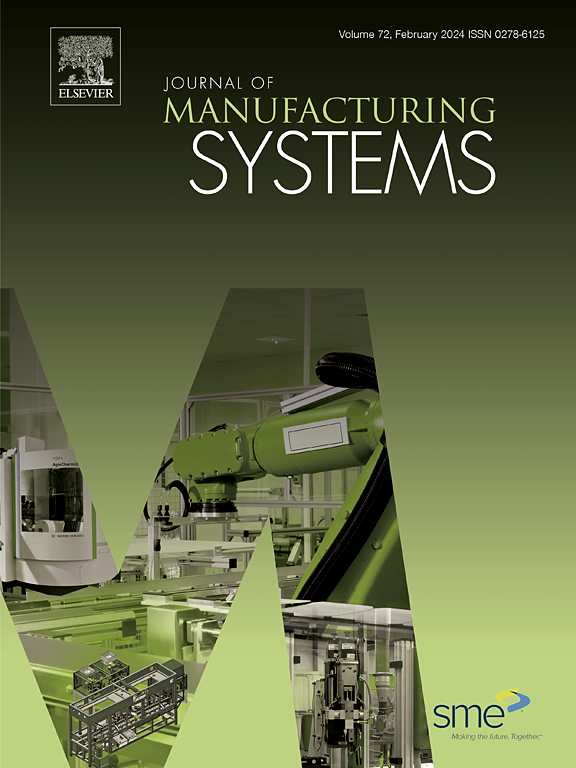Digital ergonomic assessment to enhance the physical resilience of human-centric manufacturing systems in Industry 5.0
IF 12.2
1区 工程技术
Q1 ENGINEERING, INDUSTRIAL
引用次数: 0
Abstract
The emergence of Industry 5.0 promotes the creation of human-centric values. To fulfill this objective, Internet of Things (IoT) technologies are increasingly being exploited to digitize the human factor and monitor the ergonomics of manual manufacturing systems. These digital assessments, combined with computational algorithms, contribute to the establishment of socially inclusive workplaces while offering detailed insights to safeguard the health of the aging workforce. In this scenario, this study proposes a digital architecture for evaluating the European Assembly Worksheet (EAWS) in human-centric manufacturing systems. Three distinct enabling technologies are leveraged to acquire heterogeneous data streams. A radio-frequency-based smart glove detects the operator’s interactions with the surrounding environment, while a network of marker-less cameras and a four-channel surface Electromyography (sEMG) system capture body joint movements and muscular contractions of the upper limbs, respectively. The acquired data are processed by computational algorithms to define an EAWS-driven set of Key Risk Indicators (KRIs), embedded in an ergonomic decision support system. These risk metrics highlight operator-driven process weaknesses in musculoskeletal, muscular, and material handling dimensions. Finally, the validity of the proposed digital architecture is demonstrated in an industrial-related pilot environment, where an operator assembles a piece of home furniture.
在工业 5.0 中通过数字人体工程学评估增强以人为本的制造系统的物理弹性
工业 5.0 的出现促进了以人为本价值的创造。为了实现这一目标,人们越来越多地利用物联网(IoT)技术将人的因素数字化,并对手工制造系统的人体工程学进行监测。这些数字化评估与计算算法相结合,有助于建立具有社会包容性的工作场所,同时为保障老龄化劳动力的健康提供详尽的见解。在这种情况下,本研究提出了一种数字架构,用于评估以人为本的制造系统中的欧洲装配工作表(EAWS)。利用三种不同的使能技术来获取异构数据流。基于射频的智能手套可检测操作员与周围环境的交互,而无标记摄像头网络和四通道表面肌电图(sEMG)系统则可分别捕捉身体关节运动和上肢肌肉收缩。获取的数据经计算算法处理后,定义出一套由 EAWS 驱动的关键风险指标 (KRI),并嵌入人体工程学决策支持系统。这些风险指标强调了操作员在肌肉骨骼、肌肉和材料处理方面的流程弱点。最后,在一个与工业相关的试验环境中(操作员正在组装一件家用家具),演示了所建议的数字架构的有效性。
本文章由计算机程序翻译,如有差异,请以英文原文为准。
求助全文
约1分钟内获得全文
求助全文
来源期刊

Journal of Manufacturing Systems
工程技术-工程:工业
CiteScore
23.30
自引率
13.20%
发文量
216
审稿时长
25 days
期刊介绍:
The Journal of Manufacturing Systems is dedicated to showcasing cutting-edge fundamental and applied research in manufacturing at the systems level. Encompassing products, equipment, people, information, control, and support functions, manufacturing systems play a pivotal role in the economical and competitive development, production, delivery, and total lifecycle of products, meeting market and societal needs.
With a commitment to publishing archival scholarly literature, the journal strives to advance the state of the art in manufacturing systems and foster innovation in crafting efficient, robust, and sustainable manufacturing systems. The focus extends from equipment-level considerations to the broader scope of the extended enterprise. The Journal welcomes research addressing challenges across various scales, including nano, micro, and macro-scale manufacturing, and spanning diverse sectors such as aerospace, automotive, energy, and medical device manufacturing.
 求助内容:
求助内容: 应助结果提醒方式:
应助结果提醒方式:


